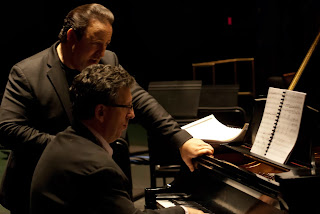Four Leaf Peat with the KSO and Knoxville Choral Society
The bagpipe is as iconic an instrument as there can be. We are blessed to share the stage with Tracy Wilson, a gifted piper who teaches music at Dandridge Elementary School. Come to find out, he is related to Terry Wilson, music director at First United Methodist Church in Maryville! I remember playing First church’s Christmas services my first year in town here. As I recall, since I was new in town, I got a little lost and a railroad crossing caused me to just barely squeak in in time that Sunday. They also were VERY forthcoming with refreshments, and that became a deciding factor in later years on choosing which Christmas gigs to bring our children to. Lol.
Tracy Wilson (left) with Knoxville Pipes and Drums members
Another lol-worthy situation has occurred, wherein I have written up a dancer who is not actually involved with the performances we are doing. The link to the Maryville Daily Times article from my last post was certainly interesting reading, but not exactly relevant. We have on the stage with us an award-winning Highland dancer, Knoxville’s own Claire Macmillan. She is nationally ranked in her field of specialty, much as Tracy Wilson is in his.
Claire Macmillan
An interesting collaboration from October has reappeared, as the Hannukah Fantasy once again teams Lucas Richman with pianist Jeffrey Biegel as co-arrangers. Mr. Biegel, as you remember, was the soloist in the premiere of Lucas’ piano concerto. Maestro Richman also has his hand in other arrangements, such as the Singalong and the music for Santa’s entrance. A really giant tip of the hat should go to Warren Clark, who arranged a great deal of the Celtic music we are reading off of this weekend. There are very few venues for which Warren has not arranged something. Ijams Park, Martin Luther King Birthday concert, Pops, runouts; he can create a soundscape out of the barest minimum of sources in a believable, readable, and sometimes humorous way.
I understand that the concerts were virtually sold out! We are very grateful with the response and are overjoyed to create memories for so many people. Have a cheery and safe holiday, Y’all!





















